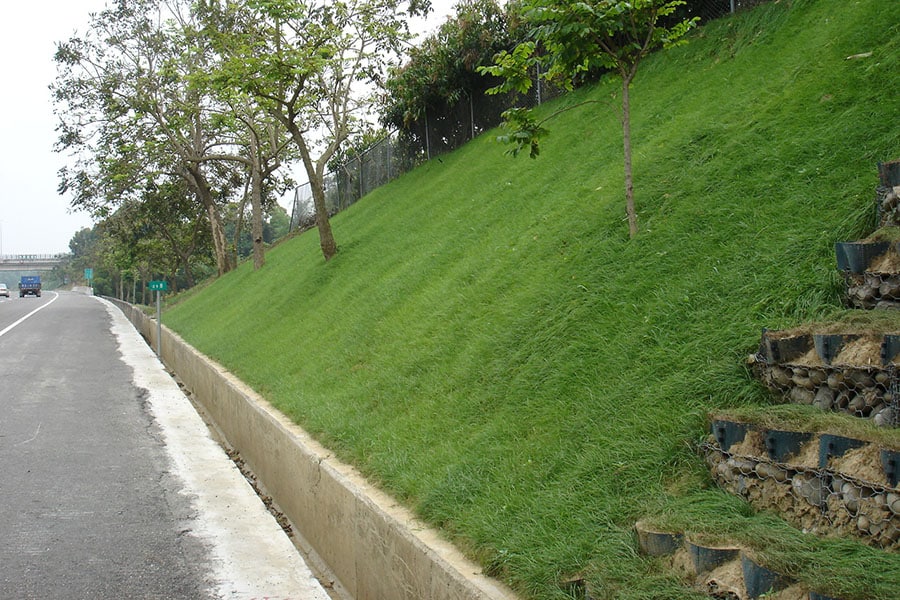Every civil engineer is familiar with soil stabilization for shorelines, hills, and other contexts.
Most recommend natural vegetation with indigenous mulch and local compost for slope protection. They believe in an effective, non-invasive means of supporting a damaged slope without environmental harm.
While this principle may be true, you may have a slope that is simply too steep. Vegetation may be out of the question since it takes time to grow and get started.
Our BaseCore engineers have products for stabilizing steep slopes that could be the answer you’re looking for long-term.
Whether you’ve already consulted senior engineers or you’re doing individual research, we hope to provide a new way to solve this common problem.
Stabilizing Steep Slopes Methods
Civilian lives are on the line if your steep slope fails, so it’s crucial to choose the right product and specs.
While you may have a traditional way of stabilizing steep slopes, we want to provide organic ways to think about the subject. Our team believes you can have a perspective shift and adopt a safe and affordable erosion control solution.
Natural Vegetation
As we mentioned, vegetation is usually the civil engineer’s first option when it comes to repairing slope failures. You shouldn’t jump to a more invasive means if it’s unnecessary.
It could harm wildlife and environmental conditions if you’re not careful, destroying your career reputation.
Vegetation and seeding are viable in areas that receive rain and provide consistent moisture for plant growth.
Overall, native plants have a major impact on restoring a slope’s strength and stability. The vegetative plants have a deep root system that prevents soil erosion and finish your project with minimal impact.
Infiltration Terraces
Vegetation adds structural soundness to any slope. But you’re prone to have the same erosion problems cycle if the slope is in a heavy rain area.
The next step to erosion control on steep slopes is to dig terraces across the hill at 50-100 foot increments.
Giving groundwater recharge at various points, the probability of erosion significantly decreases. Steep slope projects where vegetation alone couldn’t handle the job become much more effective with smart terraces.
This method also provides opportunities for planting trees, shrubs, and other large species on level, flat ground. They help the terraces in absorbing extra water in case of flash floods or emergencies.
Erosion Control Blanket
Erosion control blankets are a solution that pairs well with natural vegetation and/or infiltration terraces.
With an open weave, you can still seed the hill through the industrial jute netting for vegetation to grow. It’s a versatile product that allows for planting before or after installation.
You can also use erosion control blankets to add nutrients into the soil and aid the vegetative growth process.
Laying down sheets of this biodegradable material prevents wind and water erosion across most slope surfaces. They’re made from tight-knit fiber that holds together rolls of mulch or compost.
Our team suggests erosion control mats as a support system, not as a single solution.
Stong-Facing
Concrete, rip rap, and other aggregates are examples of stone-facing that protect shorelines and slopes from slow deterioration.
By securing the stones with a matching wire mesh system, you can secure steep slopes that normally are in danger of failure. Oceans and lakes may pull this material into the water, but you can still use stone-facing for other slope erosion contexts.
It does not always have a natural look, depending on the project location, so our team recommends vegetation first if it is viable.
Geocell
Made from high-density polyethylene (HDPE), geocell panels have incredible versatility when it comes to steep slope stabilization. You can take advantage of this product when vegetation, erosion control blankets, and stone-facing can’t get the job done.
The idea is that you stake the panels from the slope’s base to the peak and infill with the material. This could be gravel, concrete, or recycled on-site aggregate.
HDPE geocell fosters early-stage vegetation growth by giving extra support when wind and rain arrive. And you can always throw down an erosion control blanket or add aggregate if you feel it’s needed too.
Restore Impossible Slopes with Geocell
Our BaseCore engineers are passionate about solving steep slope projects with geocell.
The military has utilized these HDPE panels since the 70s for tanks and large vehicle load support. They can reduce company costs and project time by stabilizing steep slopes with geocell.
If you’re interested in learning more about the material, we’d love to answer your questions and touch base. You can discover how geocell prevents soil erosion and helps plants grow on steep slopes, retaining walls, and more.
Our team is also available to advise you with a project evaluation that offers geocell specs and testing.
Get a hold of a BaseCore engineer today by calling (888)-511-1553 or by reaching us through one of our contact methods.
